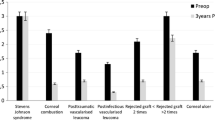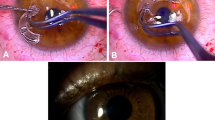Abstract.
Purpose: To analyze incidence and extent of corneal neovascularization (CN) after non-high-risk keratoplasty and to find out whether duration of postoperative topical steroid therapy (6 vs 12 months) affects CN, corneal endothelial cell count, pachymetry, aqueous flare values, and best-corrected visual acuity at 1 year after keratoplasty. Methods: Patients of the prospective Erlangen non-high-risk keratoplasty study with available high-quality corneal photographs taken preoperatively and 1 year later were analyzed (n=136). Corneal photographs were evaluated by two independent observers in a standardized semiquantitative fashion. Slides were projected with 100× magnification and corneal vessels classified into five grades with regard to the limbus, sutures and host-graft junction in each of 12 corneal sectors. Incidence and extent of CN after keratoplasty and relation to short-term (0–6 months) versus long-term (0–12 months) postoperative topical steroid therapy were analyzed. The effect of duration of topical steroid therapy on corneal endothelial cell count, pachymetry, aqueous flare values, and best corrected visual acuity was also analyzed. Of the 136 patients, 69 (51%) were randomly assigned to short-term and 67 to long-term topical prednisolone acetate 1%. Results: Fifty-eight percent of patients (n=79) developed a CN within 1 year after keratoplasty in at least one corneal sector (mean 3.1±2.2, range 1–10). At 1 year after keratoplasty, only in 12% of these patients did at least one vessel reach the host-graft junction or grow into the donor cornea, whereas in 51% vessels were seen beyond the outer suture ends of the double running suture without reaching the host-graft junction. In 37%, capillaries were located between limbus and outer suture ends. New vessels usually pointed directly or indirectly to the outer suture ends and usually were located around the 12 o'clock and 6 o'clock positions. There was no significant difference regarding incidence and extent of CN 1 year after keratoplasty between the long-term and the short-term group. Duration of topical steroid therapy had no significant effect on corneal endothelial cell count and thickness, aqueous flare values and best-corrected visual acuity at 6 and 12 months postoperatively (only at 12 months, corneas in the long-term treatment group were slightly thicker; P=0.03). Interobserver correlation of vessel assessment was 0.77 (Kendall's tau B). Conclusions: CN is a common phenomenon after non-high-risk keratoplasty. New vessels rarely reach the host-graft junction, most commonly develop from the 6 o'clock and 12 o'clock positions and are usually located between epithelium and Bowman's layer (i.e., at the level of the superficial suture). The direction of vessel growth from the limbus towards the outer suture ends suggests release of angiogenic factors in this area. Prolongation of topical steroid therapy after non-high-risk keratoplasty beyond 6 months in this study did not significantly influence incidence and extent of CN, corneal endothelial cell count, aqueous flare values and best-corrected visual acuity observed 1 year after keratoplasty.
Similar content being viewed by others
Author information
Authors and Affiliations
Corresponding author
Additional information
Electronic Publication
Rights and permissions
About this article
Cite this article
Cursiefen, C., Wenkel, H., Martus, P. et al. Impact of short-term versus long-term topical steroids on corneal neovascularization after non-high-risk keratoplasty. Graefe's Arch Clin Exp Ophthalmol 239, 514–521 (2001). https://doi.org/10.1007/s004170100313
Received:
Revised:
Accepted:
Published:
Issue Date:
DOI: https://doi.org/10.1007/s004170100313




